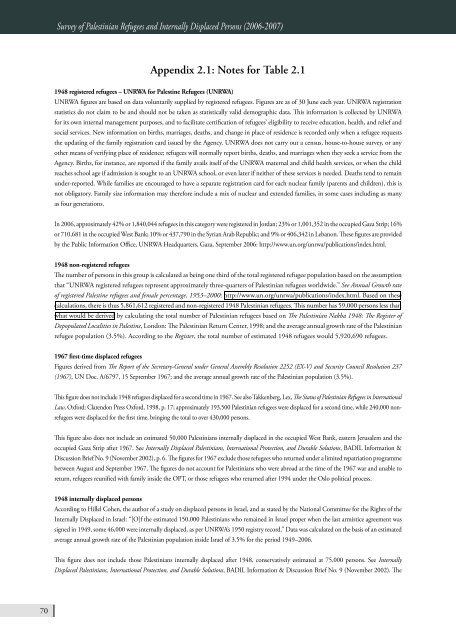BADIL Resource Center for Palestinian Residency and Refugee
BADIL Resource Center for Palestinian Residency and Refugee
BADIL Resource Center for Palestinian Residency and Refugee
Create successful ePaper yourself
Turn your PDF publications into a flip-book with our unique Google optimized e-Paper software.
70<br />
Survey of <strong>Palestinian</strong> <strong>Refugee</strong>s <strong>and</strong> Internally Displaced Persons (2006-2007)<br />
Appendix 2.1: Notes <strong>for</strong> Table 2.1<br />
1948 registered refugees – UNRWA <strong>for</strong> Palestine <strong>Refugee</strong>s (UNRWA)<br />
UNRWA figures are based on data voluntarily supplied by registered refugees. Figures are as of 30 June each year. UNRWA registration<br />
statistics do not claim to be <strong>and</strong> should not be taken as statistically valid demographic data. This in<strong>for</strong>mation is collected by UNRWA<br />
<strong>for</strong> its own internal management purposes, <strong>and</strong> to facilitate certification of refugees’ eligibility to receive education, health, <strong>and</strong> relief <strong>and</strong><br />
social services. New in<strong>for</strong>mation on births, marriages, deaths, <strong>and</strong> change in place of residence is recorded only when a refugee requests<br />
the updating of the family registration card issued by the Agency. UNRWA does not carry out a census, house-to-house survey, or any<br />
other means of verifying place of residence; refugees will normally report births, deaths, <strong>and</strong> marriages when they seek a service from the<br />
Agency. Births, <strong>for</strong> instance, are reported if the family avails itself of the UNRWA maternal <strong>and</strong> child health services, or when the child<br />
reaches school age if admission is sought to an UNRWA school, or even later if neither of these services is needed. Deaths tend to remain<br />
under-reported. While families are encouraged to have a separate registration card <strong>for</strong> each nuclear family (parents <strong>and</strong> children), this is<br />
not obligatory. Family size in<strong>for</strong>mation may there<strong>for</strong>e include a mix of nuclear <strong>and</strong> extended families, in some cases including as many<br />
as four generations.<br />
In 2006, approximately 42% or 1,840,044 refugees in this category were registered in Jordan; 23% or 1,001,352 in the occupied Gaza Strip; 16%<br />
or 710,681 in the occupied West Bank; 10% or 437,790 in the Syrian Arab Republic; <strong>and</strong> 9% or 406,342 in Lebanon. These figures are provided<br />
by the Public In<strong>for</strong>mation Office, UNRWA Headquarters, Gaza, September 2006: http://www.un.org/unrwa/publications/index.html.<br />
1948 non-registered refugees<br />
The number of persons in this group is calculated as being one third of the total registered refugee population based on the assumption<br />
that “UNRWA registered refugees represent approximately three-quarters of <strong>Palestinian</strong> refugees worldwide.” See Annual Growth rate<br />
of registered Palestine refugees <strong>and</strong> female percentage, 1953–2000: http://www.un.org/unrwa/publications/index.html. Based on these<br />
calculations, there is thus 5,861,612 registered <strong>and</strong> non-registered 1948 <strong>Palestinian</strong> refugees. This number has 59,000 persons less than<br />
what would be derived by calculating the total number of <strong>Palestinian</strong> refugees based on The <strong>Palestinian</strong> Nakba 1948: The Register of<br />
Depopulated Localities in Palestine, London: The <strong>Palestinian</strong> Return <strong>Center</strong>, 1998; <strong>and</strong> the average annual growth rate of the <strong>Palestinian</strong><br />
refugee population (3.5%). According to the Register, the total number of estimated 1948 refugees would 5,920,690 refugees.<br />
1967 first-time displaced refugees<br />
Figures derived from The Report of the Secretary-General under General Assembly Resolution 2252 (EX-V) <strong>and</strong> Security Council Resolution 237<br />
(1967), UN Doc. A/6797, 15 September 1967; <strong>and</strong> the average annual growth rate of the <strong>Palestinian</strong> population (3.5%).<br />
This figure does not include 1948 refugees displaced <strong>for</strong> a second time in 1967. See alsoTakkenberg, Lex, The Status of <strong>Palestinian</strong> <strong>Refugee</strong>s in International<br />
Law, Ox<strong>for</strong>d: Clarendon Press Ox<strong>for</strong>d, 1998, p. 17; approximately 193,500 <strong>Palestinian</strong> refugees were displaced <strong>for</strong> a second time, while 240,000 non-<br />
refugees were displaced <strong>for</strong> the first time, bringing the total to over 430,000 persons.<br />
This figure also does not include an estimated 50,000 <strong>Palestinian</strong>s internally displaced in the occupied West Bank, eastern Jerusalem <strong>and</strong> the<br />
occupied Gaza Strip after 1967. See Internally Displaced <strong>Palestinian</strong>s, International Protection, <strong>and</strong> Durable Solutions, <strong>BADIL</strong> In<strong>for</strong>mation &<br />
Discussion Brief No. 9 (November 2002), p. 6. The figures <strong>for</strong> 1967 exclude those refugees who returned under a limited repatriation programme<br />
between August <strong>and</strong> September 1967. The figures do not account <strong>for</strong> <strong>Palestinian</strong>s who were abroad at the time of the 1967 war <strong>and</strong> unable to<br />
return, refugees reunified with family inside the OPT, or those refugees who returned after 1994 under the Oslo political process.<br />
1948 internally displaced persons<br />
According to Hillel Cohen, the author of a study on displaced persons in Israel, <strong>and</strong> as stated by the National Committee <strong>for</strong> the Rights of the<br />
Internally Displaced in Israel: “[O]f the estimated 150,000 <strong>Palestinian</strong>s who remained in Israel proper when the last armistice agreement was<br />
signed in 1949, some 46,000 were internally displaced, as per UNRWA’s 1950 registry record.” Data was calculated on the basis of an estimated<br />
average annual growth rate of the <strong>Palestinian</strong> population inside Israel of 3.5% <strong>for</strong> the period 1949–2006.<br />
This figure does not include those <strong>Palestinian</strong>s internally displaced after 1948, conservatively estimated at 75,000 persons. See Internally<br />
Displaced <strong>Palestinian</strong>s, International Protection, <strong>and</strong> Durable Solutions, <strong>BADIL</strong> In<strong>for</strong>mation & Discussion Brief No. 9 (November 2002). The

















